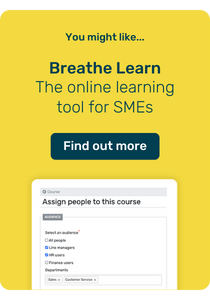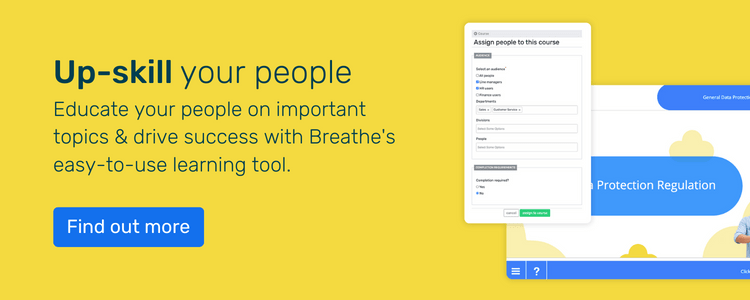How do you approach employee training and development? Although an organisation's capacity to grow is defined by how it approaches staff development, some SMEs find themselves on the back foot when it comes to creating a meaningful learning & development strategy.
A Forbes article states that employee retention, productivity, creativity & motivation will all improve for organisations who provide the right employee training opportunities.
And the benefits don't end there. Employee training and development is also an essential part of growing a positive company culture (which naturally encourages employees to stick around).
It's all very well understanding the importance of training and development, but actually identifying your employees' needs is the crucial bit. Get it wrong and you could be wasting valuable time and money on training that may not be necessary.
So how do you find out what training and development your employees need? Here's a useful step-by-step guide:
7 steps for identifying employee training needs
1. Set clear expectations for each role
To identify employee training and development needs, you must first set clear expectations for each role within your business. This creates a benchmark to monitor performance against.
Review job descriptions when new positions are created, or when making substantial changes to existing roles. Remember to periodically account for smaller changes as well.
Doing this makes it easier to understand what skills an employee needs if they are to be successful in each role. And in turn this helps you identify skills gaps and potential training and development needs.
2. Monitor employee performance
Measuring and monitoring performance should be embraced as a means of supporting employees (not penalising them) and can be a valuable tool in identifying development opportunities.
Set clear goals for employees and respond to performance blips on an individual basis. Understanding why performance is off kilter puts you in a better position to respond positively and offer appropriate training.
Conversely, if an employee continuously over delivers, you could work with them to set more challenging goals to stretch their abilities.
3. Ask away
Now this may seem obvious, but employee feedback can be a valuable addition to your SMEs training and development plan.
Instead of traditional employee surveys, use focused employee evaluation to encourage honest and open feedback. This will create helpful dialogue about career development and help you identify specific employee training requirements.
You don’t need to set up special meetings – use regular one-to-ones or performance reviews for open conversations and honest feedback.
Don’t restrict your business to individual level feedback, ask managers for feedback on employees and compare that with employee self-evaluation to identify differences. It is equally useful to ask for employee feedback on managers.
4. Analysis (and lots of it)
You’ll already have your SME's strategies and goals set up. Complement this with an analysis of the work that delivers those goals. This should help you identify employee training and development needs that are specific to each team and job.
Tapping into what's going on under the surface will help you spot gaps in your training and development schedule.
It’s likely that training and development needs will fall into one of three categories:
-
Improving staff knowledge about your industry
-
Job-related needs
-
Personal development
5. Make the most of personal development plans
Giving employees the opportunity to lead their personal development can have a profound effect on their motivation and their engagement in your business.
Well-managed personal development plans improve communication and will also help you identify any relevant training and development needs.
Use cloud-based HR software such as Breathe – this way both the employee and their manager can easily stay on top of objectives and performance.
6. Use focus group to understand employee training and development needs
Focus groups are a useful tool to help you identify training and development needs within your business. A focus group looks at a cross-section of employees within your business under the guidance of an expert facilitator.
They are a useful way of gathering employees’ views and opinions about current training and how to improve what is on offer. Focus groups also help demonstrate that you are genuinely interested in your employees' opinions.
7. Set up a system of mentoring & coaching
Closely aligning staff with a mentor will help develop skills while identifying additional employee training and development needs. Mentoring programmes are a great way of helping employees succeed in their careers and can be as powerful for the mentors as they are for the mentees.
And don’t think that it needs to be senior managers mentoring younger employees. Reverse mentoring can be just as powerful.
Current trends in employee training
The way we approach employee training is changing. Here are a few trends worth considering when thinking about your team’s development needs:
-
Soft skills matter too
Skills like communication and problem-solving are in demand, especially for managers and customer-facing roles. -
Digital tools are on the rise
E-learning and online training platforms help identify where support is needed and give people the flexibility to build their skills wherever they're working. -
Learning is more personalised
One-size-fits-all training is fading. More SMEs are tailoring development to individual roles and goals. -
Employee input is key
Regular check-ins and feedback help uncover what’s missing and what’s working.
Measuring training effectiveness
Once a training and development programme is up and running, it’s important to check whether it’s having the right impact. Measuring training effectiveness helps you understand if your plan is supporting employee performance and long-term growth.
-
Return to the goal
What was the training designed to support - technical skills, soft skills, confidence, or a new way of working? -
Talk to your team
Ask how they found the training, and whether it’s made a difference. Sometimes the most useful insights come from conversations. -
Look for signs of progress
Even small changes in how people work or feel can show that the training’s helping.
Everyone learns in their own way and at their own pace. Taking time to check in can give you a clearer sense of how the training is landing, and whether anything might benefit from a gentle adjustment.
L&D for your team
Breathe's Learn module can help you up-skill your people and drive success. Discover training courses for employees in our e-learning platform.
Frequently asked questions
What is a comprehensive approach to training needs analysis?
A well-rounded approach to staff training looks at more than just one source. It includes what your people say they need, how they’re doing in their roles, and what’s changing in your industry. Bringing these together helps you decide where training will be most useful, for your team and the business.
How to adjust training based on employee feedback?
Listening to employee feedback is an easy way to review your training and development programmes. It helps you understand what’s working, where there are gaps, and how to make learning more meaningful.
Start by opening up the conversation in one-to-ones, performance reviews or surveys.. Ask questions about the training content, how it was delivered, and whether the skills learned are practical and relevant to day-to-day work.
Once you’ve gathered feedback you can use this feedback to adjust your training plan. This might mean adding new topics, changing how sessions are delivered or providing extra support where needed.

Author: Laura Sands
Laura is a writer who enjoys getting into the detail of subjects and sharing that knowledge with snappy, interesting content. When not typing away, she enjoys walks in the woods and curling up with a good book and mug of something hot.





